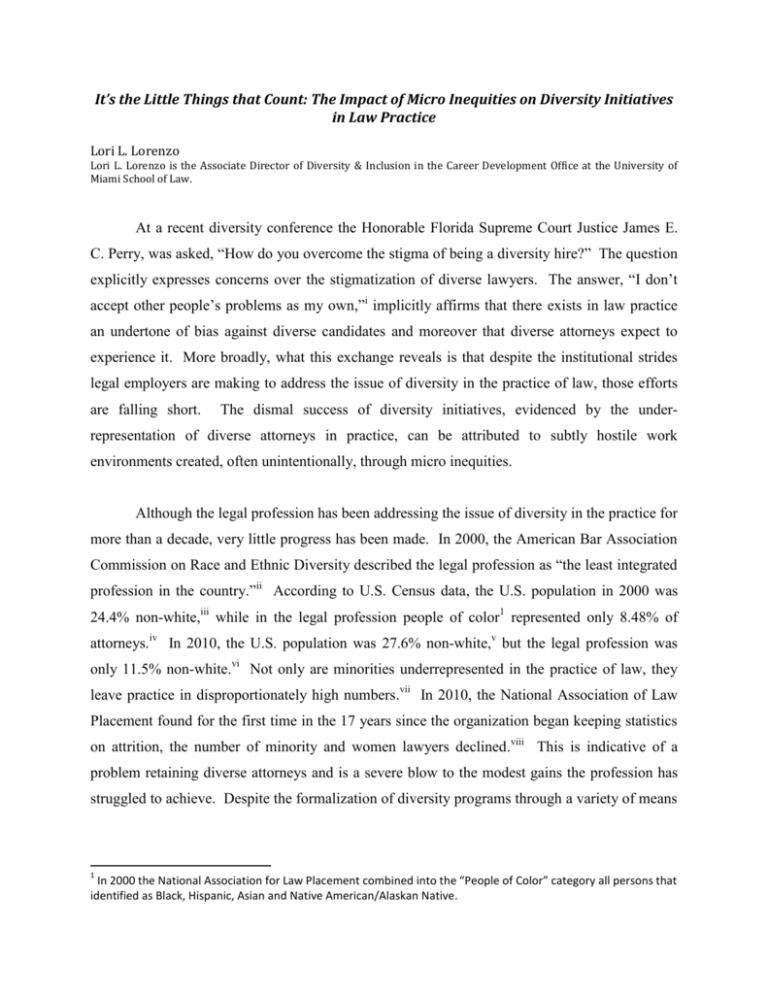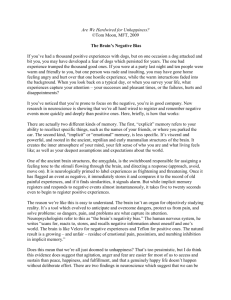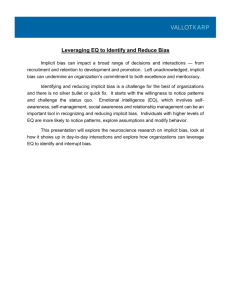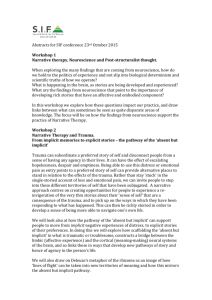It's the Little Things that Count: The Impact of Micro Inequities on
advertisement

It’s the Little Things that Count: The Impact of Micro Inequities on Diversity Initiatives in Law Practice Lori L. Lorenzo Lori L. Lorenzo is the Associate Director of Diversity & Inclusion in the Career Development Office at the University of Miami School of Law. At a recent diversity conference the Honorable Florida Supreme Court Justice James E. C. Perry, was asked, “How do you overcome the stigma of being a diversity hire?” The question explicitly expresses concerns over the stigmatization of diverse lawyers. The answer, “I don‟t accept other people‟s problems as my own,”i implicitly affirms that there exists in law practice an undertone of bias against diverse candidates and moreover that diverse attorneys expect to experience it. More broadly, what this exchange reveals is that despite the institutional strides legal employers are making to address the issue of diversity in the practice of law, those efforts are falling short. The dismal success of diversity initiatives, evidenced by the under- representation of diverse attorneys in practice, can be attributed to subtly hostile work environments created, often unintentionally, through micro inequities. Although the legal profession has been addressing the issue of diversity in the practice for more than a decade, very little progress has been made. In 2000, the American Bar Association Commission on Race and Ethnic Diversity described the legal profession as “the least integrated profession in the country.”ii According to U.S. Census data, the U.S. population in 2000 was 24.4% non-white,iii while in the legal profession people of color1 represented only 8.48% of attorneys.iv In 2010, the U.S. population was 27.6% non-white,v but the legal profession was only 11.5% non-white.vi Not only are minorities underrepresented in the practice of law, they leave practice in disproportionately high numbers.vii In 2010, the National Association of Law Placement found for the first time in the 17 years since the organization began keeping statistics on attrition, the number of minority and women lawyers declined.viii This is indicative of a problem retaining diverse attorneys and is a severe blow to the modest gains the profession has struggled to achieve. Despite the formalization of diversity programs through a variety of means 1 In 2000 the National Association for Law Placement combined into the “People of Color” category all persons that identified as Black, Hispanic, Asian and Native American/Alaskan Native. and the allocation of significant resources, diversity initiatives have not had the impact one might expect. Evaluated broadly, diversity initiatives appear to address the issues preventing diverse attorneys from being successful in practice. The attrition statistics clearly indicate, however, that an environment exists which is subtly inhospitable to non-majority attorneys. This environment, created through micro inequities, is a result of implicit biases. Implicit biases are stereotypes harbored by individuals which influence automatic and unintentional expressions.ix Implicit biases are developed over time and are not consciously acknowledged by the holder; x frequently, an individual‟s implicit biases are in direct opposition to that individual‟s explicit beliefs. To study implicit bias researchers use the Implicit Association Test which requires test takers to associate, for example, African American faces with pleasant or unpleasant words and then do the same for European American faces using a computer program.2 The computer measures the frequency of association and the time it takes to make the associations to determine the existence and degree of implicit bias in the test taker.xi Implicit biases can be harmless where the bias closely, if not completely, matches the characteristics of all members of the group which is stereotyped (e.g. all professional athletes are physically fit).xii They create a problem, however, when they do not match the characteristics of all members of the stereotyped group. Social psychologists commonly find this dissociation in beliefs relating to the elderly, disabled and religious groups and associated with gender, sexuality and weight.xiii Where dissociation exists, the outward expression of implicit biases, called micro inequities, are usually deleterious. Micro inequities are small, short-lived, unintentional acts which communicate difference and rejection.xiv They are relayed through inflection and body language usually in a way that even the communicator does not intend or acknowledge,xv although micro inequities are destructive regardless of the speaker‟s intent.xvi In law practice micro inequities can manifest in a number of ways including the failure to provide feedback or recognition, or the selection of attorneys for high profile projects or for introduction to clients. They can also manifest in less obvious ways such as limited eye contact, greater seating distancexvii or in casual conversation. For example, conversations on golf, wine and travel favor associates from higher socio-economic 2 For an interesting exercise in implicit bias visit http://implicit.harvard.edu/. backgrounds, as those from lower socio-economic backgrounds may not have much, if any, exposure to these topics. The inability to contribute to the conversation leaves the individual feeling excluded and rejected, even though the conversations are on “neutral” subjects and are open to anyone to participate. This phenomenon of indirect rejection in neutral situations explains why diverse attorneys often struggle to articulate the exact reason they feel excluded. Micro inequities cumulatively craft a social understanding of who is included and who is excluded creating “an institutional climate that may marginalize and alienate reproducing hierarchies of inequality despite the institutional commitment to formal equality.” xviii One compelling study on the effects of micro inequities on the educational and professional development of medical students found that although neither the institution nor the students felt there were any “issues” with race, gender or homophobia in the institution, students reported that being a student of color, female, identifying as gay, lesbian, bisexual or transgender or originating in any social class less than upper middle class had a noticeably negative impact on their medical school experience and limited their ability to feel as though they belonged in the environment. In some cases it also impacted the career decision of students (e.g. students from lower socioeconomic status choosing to work in a low-income clinic instead of in private practice). This study concretely demonstrates the potency of micro inequities in creating an environment which dramatically affects a student‟s ability to assimilate.xix Many of the findings could easily obtain in legal settings. Because law practice continues to be an Anglo, male dominated profession, many decision makers, even the most diversity oriented ones, are unaware an issue even exists: “In a predominately white male culture, it is exceptionally difficult to stop micro inequities because they are so culturally „normal‟ they are simply not noticed.”xx Furthermore, the advantages enjoyed by majority decision makers appear, to their perception, to be available to anyone who wants them.xxi It is interesting to note, however, that participants that are made aware of the goals of the Implicit Association Test are able to manipulate the test by purposely increasing response times for some associations, while decreasing response times for others, thereby producing test results which indicate little or no implicit bias. In other words, by becoming aware of the issue and controlling responses the impact of implicit bias can be reduced or eliminated. Thus, by educating and training legal professionals to recognize implicit biases and purposefully alter micro inequitable behaviors, the indirect rejection and subtle workplace hostility experienced by diverse attorneys could be reduced allowing the legal profession to finally enjoy success in its diversity initiatives. i Honorable Justice James E. C. Perry, Florida Supreme Court, Keynote Address at the Palm Beach County bar Association‟s Second Biennial Diversity Summit (Oct. 14, 2011). ii Dale J. Giali, Diversity in the Legal Profession, http://www.dailyjournal.com/cle.cfm?show=CLEDisplayArticle&qVersionID=82&eid=851636&evid=1. iii All Across the U.S.A.: Population Distribution and Composition, 2000, Population Profile of the United States: 2000 (Internet Release) U.S. Census Bureau. iv American Bar Association, Lawyer Demographics Report, Market Research Department (2009). v Karen R Humes et al., Overview of Race and Hispanic Origin: 2010, U.S. Department of Commerce Economics and Statistics Administration U.S. Census Bureau (March 2011). vi A Closer Look at NALP Findings on Women and Minorities in Law Firms by Race and Ethnicity, NALP Bulletin, January 2011. vii Tammy Patterson, Associate Attrition in 2009: Looking Back in Order to Move Ahead, NALP Bulletin, June 2010. viii Id. ix Laurie A. Rudman, Social Justice in Our Minds, Homes, and Society: The Nature, Causes and Consequences of Implicit Bias, 17 Soc. Just. Res. 129, 133-134 (2004). x Anthony G. Greenwald & Linda Hamilton Krieger, Implicit Bias: Scientific Foundations, 94 Cal. L. Rev. 945, 951 (2006). xi Id. at 945. xii Id. at 949. xiii Daniel Kelly & Ron Mallon, Making Race Out of Nothing: Psychologically Constrained Social Roles, Oxford Handbook of Philosophy and Social Sciences (forthcoming) (manuscript at 17). xiv Mary Rowe, Micro-Affirmations & Micro-Inequities, 1 J. Int‟l. Ombudsman Ass‟n. 45, 45 (2008). xv Stephen Young, Partner and Founder, Insight Education Systems, Presentation at the NALP 2011 Diversity Summit: Microinequities: The Power of Small (June 10, 2011). xvi Mary P. Rowe, Barriers to Equality: The Power of Subtle Discrimination to Maintain Unequal Opportunity, 3 Emp. Resp. & Rts. J. 153, 157 (1990). xvii Greenwald, supra note x, at 955. xviii Brenda Beagan, Micro Inequities and Everyday Inequalities: “Race,” Gender, Sexuality and Class in Medical School, 26 Can. J. Soc. 583, 583 (2001). xix Id. at 606. xx Rowe, supra note xvi, at 160. xxi David Tulin, Law Firm Excellence Through Diversity and Inclusion, September 16, 2011, presented at the SouthMiami Kendall Bar Association Diversity Summit, quoting Bill Proudman, MCCA (2005).








